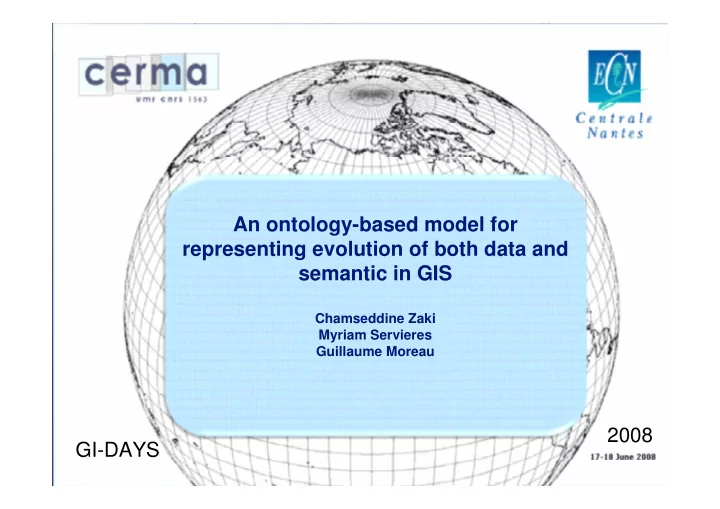

An ontology-based model for representing evolution of both data and semantic in GIS Chamseddine Zaki Myriam Servieres Guillaume Moreau 2008 GI-DAYS
Plan Introduction Related Work: Snapshot Model Three domain Model MADS Ontologies Our Approach Objective MADS + ONTOLOGIES History tracking Conclusion 2 GI-DAYS 2008
Introduction - GIS Geographic Information Systems The goal of GIS is to provide information about a given space. Layers Geographical objects organized in themes frequently represented as layers. Data in GIS Objects are either spatial or spatio-temporal. 3 GI-DAYS 2008
Introduction : Exigencies Historicity Enrich spatial analysis by an evolutionary study of the considered objects. Dynamicity Models should be able to represent the concept evolution through time. Multi-Presentation, Multi-Resolution Geographical applications have strong requirements in terms of multiple presentations. 4 GI-DAYS 2008
Related Work – Snapshot Model Snapshot Model (1988) Time Stamping Layers This model uses time-stamping layers that show the states of a geographic distribution, at a certain time. Problems (complex queries, redundancy …) 5 GI-DAYS 2008
Related Work – Three Domain Model Three Domain Model (1994) Three Dimensions (Semantics, Space and Time) The semantic domain holds uniquely identifiable objects. Improvements 1. Handling Both movements and changes 2. Handling simple and complex, temporal and spatio-temporal queries. 6 GI-DAYS 2008
Related Work – MADS Modeling of Application Data with Spatio- Temporal features (1998) Spatial Data Types 7 GI-DAYS 2008
Related Work – MADS Temporal Data Types 8 GI-DAYS 2008
Related Work – MADS • Dimensions (Spatial, Temporal, Structural). • Multiple Perception using perception stamps. • Multiple Presentation Techniques. • Problems? Closed World Assumption. Impossible update of the Underlying model. 9 GI-DAYS 2008
Related Work – Ontologies Definition Interesting features Advantages over the MADS model: Open World Assumption. Ability to update the conceptual model. 10 GI-DAYS 2008
Our Approach 11 GI-DAYS 2008
Our Approach : Objective A new model that insures: Multi-presentation of geographic objects. Ability of Adding, removing, and changing concepts. Keeping track of the historical data of instances and concepts. 12 GI-DAYS 2008
Our Approach: MADS + Ontologies Combining MADS and Ontologies. • MADS • Mapping MADS to an Ontology • History tracking 13 GI-DAYS 2008
Example: MADS model 14 GI-DAYS 2008
Example: MADS model A "Dense Core" is composed of "Structure Types". Structure Types are "Building", "Road" and "Land". Buildings can be public or private. Many lands may be joined together to form one land, or a land can be split in many smaller lands. Roads have borders with lands. 15 GI-DAYS 2008
Example: Mapping MADS to Ontology Translating the MADS model into a web ontology language (OWL) using transformation rules. 16 GI-DAYS 2008
Example: History Tracking Object creation : “Begin”. A new entity derived from a previous existing object: “Begin-Replaced”. Each change will have a specific value (Change in geometry, in topology, in attribute, in geometry, in topology and attribute …). Object Destruction: End 17 GI-DAYS 2008
Example: History Tracking Relationship 1: Value = “Begin”, Start Node = “T1”, Finish Node= “T1”, Instance ID = “Land A”. Relationship 2: Value = “No Change”,… Relationship 3: Value = “Change in Geometry and Topology”, Start Node = “T3”, Finish Node= “T4”, Instance ID = “Land A”… 18 GI-DAYS 2008
Conclusion A solution that allows the evolution of spatio- temporal data models in terms of concepts. Multiple models that contributed in this domain. MADS in detail, and his shortcomings. Combining MADS and Ontologies. Mapping the MADS model to a new ontology. Explicit temporal relationship in the ontology model. Future Works: Application of this model on the geographic data of Nantes. 19 GI-DAYS 2008
Thank You For Your Attention Chamseddine Zaki Myriam Servieres Guillaume Moreau 2008 20 GI-DAYS
Recommend
More recommend